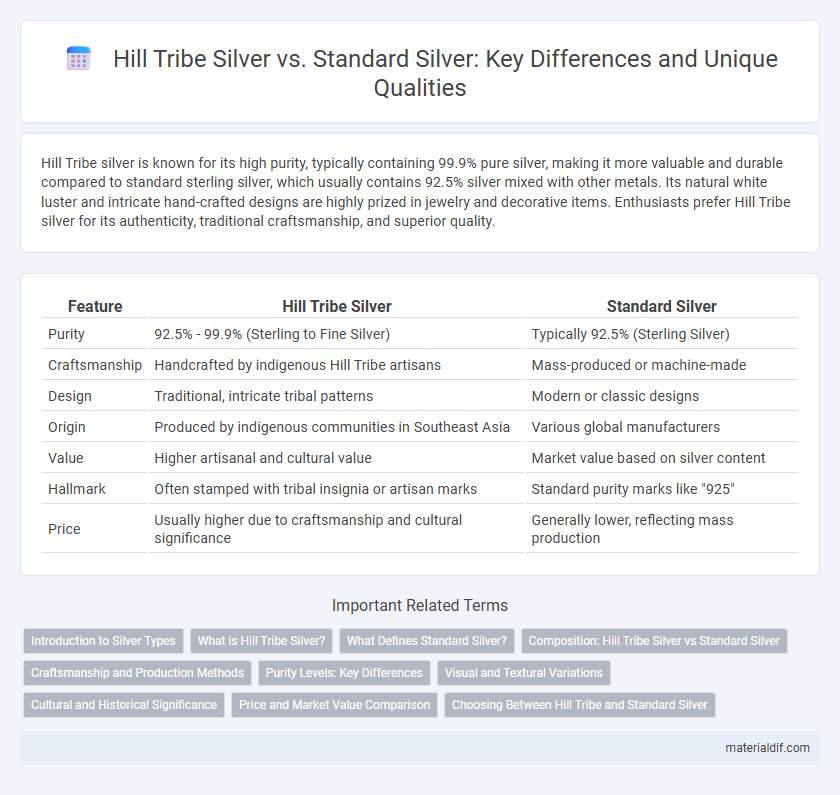Hill Tribe silver is known for its high purity, typically containing 99.9% pure silver, making it more valuable and durable compared to standard sterling silver, which usually contains 92.5% silver mixed with other metals. Its natural white luster and intricate hand-crafted designs are highly prized in jewelry and decorative items. Enthusiasts prefer Hill Tribe silver for its authenticity, traditional craftsmanship, and superior quality.
Table of Comparison
| Feature | Hill Tribe Silver | Standard Silver |
|---|---|---|
| Purity | 92.5% - 99.9% (Sterling to Fine Silver) | Typically 92.5% (Sterling Silver) |
| Craftsmanship | Handcrafted by indigenous Hill Tribe artisans | Mass-produced or machine-made |
| Design | Traditional, intricate tribal patterns | Modern or classic designs |
| Origin | Produced by indigenous communities in Southeast Asia | Various global manufacturers |
| Value | Higher artisanal and cultural value | Market value based on silver content |
| Hallmark | Often stamped with tribal insignia or artisan marks | Standard purity marks like "925" |
| Price | Usually higher due to craftsmanship and cultural significance | Generally lower, reflecting mass production |
Introduction to Silver Types
Hill Tribe silver, traditionally handcrafted by ethnic groups in Southeast Asia, is known for its high purity level, often exceeding 95% silver content, compared to standard sterling silver which commonly contains 92.5% silver. The intricate designs in Hill Tribe silver reflect cultural heritage and craftsmanship, using a unique alloy that enhances durability without compromising the metal's natural luster. Standard silver, typically standardized by ISO regulations, balances affordability and quality for mass production, while Hill Tribe silver emphasizes authenticity and artisanal value.
What is Hill Tribe Silver?
Hill Tribe silver is handcrafted by indigenous artisans from northern Thailand, known for its high purity, often ranging from 95% to 99.9% silver content, which exceeds the standard 92.5% sterling silver. This silver reflects traditional techniques passed down through generations, featuring distinctive textures and patterns that highlight cultural heritage and craftsmanship. Unlike standard silver, Hill Tribe silver is prized for its unique handmade quality and cultural significance, making it highly valued in both jewelry and collectible markets.
What Defines Standard Silver?
Standard silver, often referred to as sterling silver, is defined by its composition of 92.5% pure silver and 7.5% other metals, typically copper, to enhance durability and strength. This alloy standard ensures consistent quality, luster, and resistance to tarnish, making it suitable for fine jewelry and silverware. Unlike Hill Tribe silver, which may vary in purity and feature traditional handmade designs, standard silver adheres to strict industry regulations and hallmarking for authenticity.
Composition: Hill Tribe Silver vs Standard Silver
Hill Tribe silver typically contains 99.9% pure silver, making it finer than standard sterling silver, which is usually composed of 92.5% silver and 7.5% other metals like copper. The higher purity level in Hill Tribe silver results in a brighter luster and greater malleability, favored in intricate handcrafted jewelry. Standard sterling silver's alloy composition enhances durability, making it suitable for everyday wear but less bright compared to Hill Tribe silver.
Craftsmanship and Production Methods
Hill Tribe silver is renowned for its meticulous hand-hammered craftsmanship, reflecting centuries-old artisanal techniques passed down through generations. Unlike standard silver, which is often mass-produced using modern machinery, Hill Tribe silver emphasizes unique, detailed designs created through traditional methods such as hand-forging and hand-stamping. This artisanal approach results in distinctive textures and cultural motifs, making each piece a one-of-a-kind work of art with superior craftsmanship quality.
Purity Levels: Key Differences
Hill Tribe silver typically boasts a higher purity level, often ranging between 95% to 99% silver, whereas standard sterling silver contains 92.5% silver. This increased purity enhances the metal's luster and hypoallergenic properties, making Hill Tribe silver a preferred choice in artisanal jewelry. The remaining metal content in Hill Tribe silver usually consists of copper or other trace elements, contributing to its distinctive strength and malleability.
Visual and Textural Variations
Hill Tribe silver exhibits unique visual and textural variations characterized by intricate hand-stamped patterns and a distinct matte finish that contrasts with the smooth, polished surface typical of standard silver. The artisanal craftsmanship of Hill Tribe silver results in irregular textures and raised motifs, enhancing its tactile appeal and visual depth. Standard silver often appears uniform and reflective, lacking the culturally rich, handcrafted imperfections found in Hill Tribe silver.
Cultural and Historical Significance
Hill Tribe silver, primarily crafted by indigenous communities in regions like Northern Thailand, carries deep cultural and historical significance, reflecting centuries-old traditions in intricate handwork and symbolic designs. Unlike standard silver, often mass-produced with uniform patterns, Hill Tribe silver embodies unique tribal identities and ancestral heritage, serving as a tangible link to the artisans' cultural roots. This artisanal approach highlights the silver's value beyond material worth, emphasizing its role in preserving and celebrating indigenous craftsmanship and history.
Price and Market Value Comparison
Hill Tribe silver, known for its unique handcrafted designs and cultural significance, often commands higher market value compared to standard silver due to its artisanal quality and rarity. Standard silver, typically used in mass-produced jewelry, has a lower price point driven by uniformity and accessibility. Market trends show increasing demand for Hill Tribe silver in luxury and collectors' markets, elevating its price beyond the conventional silver items.
Choosing Between Hill Tribe and Standard Silver
Hill Tribe silver, known for its higher purity often exceeding 95% silver content compared to the typical 92.5% of standard sterling silver, offers unique handmade craftsmanship with intricate tribal designs that reflect cultural heritage. Choosing between Hill Tribe and standard silver depends on valuing artisanal authenticity and purity versus affordability and widespread availability.
Hill Tribe silver vs Standard silver Infographic

 materialdif.com
materialdif.com